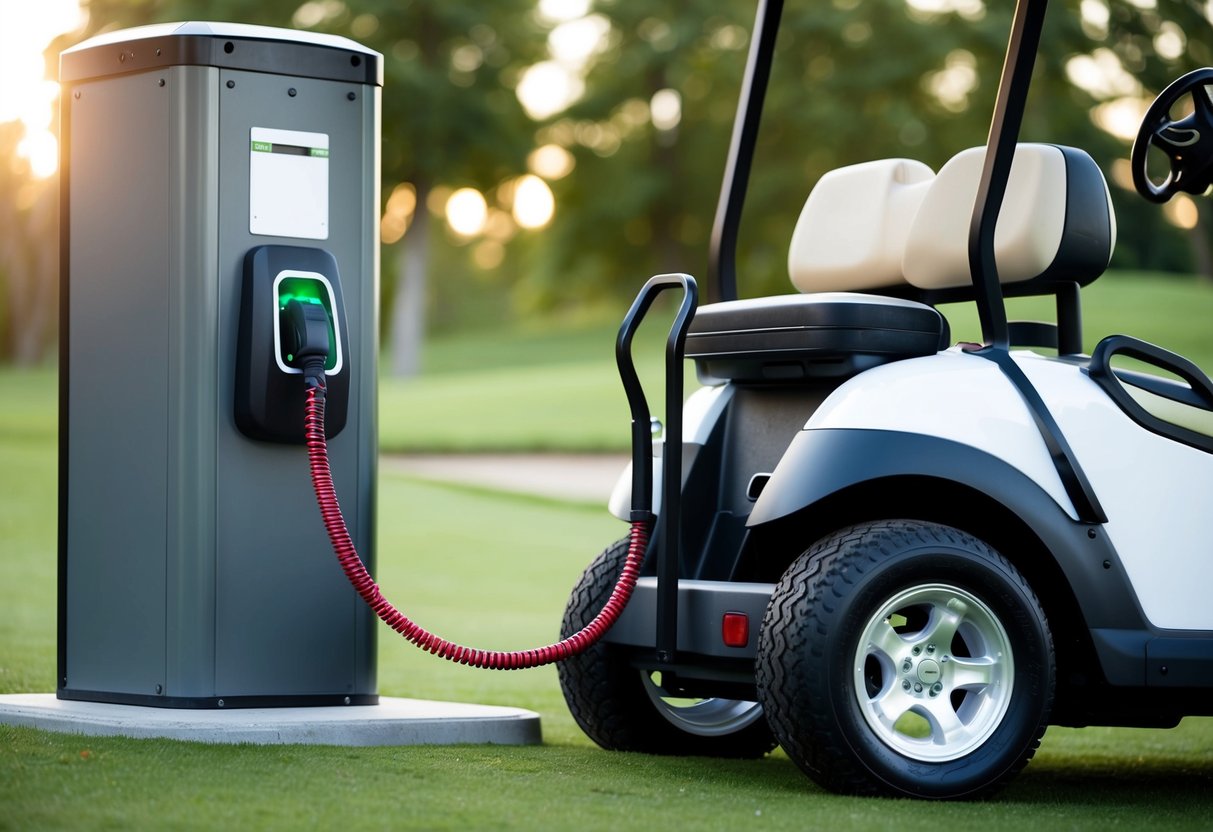Check out our golf rangefinders by Vovex to elevate your game!
Golf cart charging times can vary significantly depending on several factors. Most golf carts take between 4 to 8 hours to fully charge from a depleted state. The exact duration depends on the battery capacity, charger output, and the cart's current charge level.
We've found that newer lithium-ion batteries tend to charge faster than traditional lead-acid batteries. A 48-volt lithium-ion golf cart battery might reach full charge in as little as 2-3 hours with a high-output charger. Lead-acid batteries typically require 6-8 hours for a complete charge cycle.
It's important to note that partial charges are often quicker. If your golf cart battery is only partially depleted, it may only need an hour or two to top up. Regular maintenance and proper charging habits can help optimize your cart's battery life and charging efficiency.
Key Takeaways
- Golf cart charging typically takes 4-8 hours for a full charge
- Battery type and charger output significantly impact charging speed
- Regular maintenance and proper charging habits optimize battery performance
Understanding Golf Cart Batteries
Golf cart batteries are the heart of electric carts, powering them for rounds of golf and other uses. We'll explore the main types and explain key concepts like capacity and voltage.
Types of Golf Cart Batteries
Lead-acid batteries are the most common in golf carts. They come in two main varieties: flooded (wet cell) and sealed. Flooded batteries require regular watering and maintenance. Sealed batteries, including AGM and gel types, are maintenance-free but typically more expensive.
Lithium-ion batteries are gaining popularity. They're lighter, charge faster, and last longer than lead-acid options. However, they come with a higher upfront cost.
Capacity and Voltage Explained
Battery capacity is measured in amp-hours (Ah). A higher Ah rating means the battery can provide power for a longer time. Most golf cart batteries range from 150 to 250 Ah.
Voltage determines the power output. Golf carts usually use 36V or 48V systems, consisting of multiple 6V or 8V batteries connected in series. Higher voltage systems generally offer better performance and efficiency.
Battery life varies based on usage and maintenance. With proper care, lead-acid batteries can last 4-6 years, while lithium-ion batteries may last 8-10 years or more.
Charging Basics
Golf cart charging involves straightforward steps to keep your vehicle ready for the course. We'll cover the key aspects of preparing your cart and carrying out the charging process.
Preparing for Charging
Before plugging in your golf cart, we always check the battery water levels. It's crucial to top up with distilled water if needed, but be careful not to overfill. We also make sure the charging area is well-ventilated and free from flammable materials.
Next, we inspect the battery terminals for corrosion. A simple mixture of baking soda and water works wonders for cleaning them. We use a wire brush to scrub away any buildup, ensuring a solid connection.
Lastly, we verify that the charger is compatible with our golf cart's battery system. Using the wrong charger can damage the batteries or reduce their lifespan.
The Charging Process
To start charging, we connect the charger to the golf cart's charging port. Most modern carts have an onboard computer that manages the charging cycle automatically. We typically plug in our cart after each use to maintain battery health.
The charging time varies depending on battery type and capacity. Lead-acid batteries often take 6-8 hours for a full charge, while lithium-ion batteries charge faster, usually in 2-4 hours.
We avoid interrupting the charging cycle, as this can affect battery performance. Many chargers have indicator lights: red for charging, green for fully charged. We unplug the charger promptly once charging is complete to prevent overcharging.
Regular charging habits extend battery life. We aim to keep our batteries above 50% charge and avoid deep discharges whenever possible.
Factors Affecting Charge Time
Several key elements influence how long it takes to fully charge a golf cart battery. We'll explore the main factors that impact charging duration and efficiency.
Battery Age and Health
As golf cart batteries age, their capacity to hold a charge diminishes. Older batteries typically require more time to reach full charge. Well-maintained batteries in their prime can charge up to 20% faster than those nearing the end of their lifespan.
Battery health also plays a crucial role. Regular deep discharges or inadequate maintenance can lead to sulfation, reducing the battery's ability to accept and hold a charge. This often results in longer charging times.
To maximize battery health and minimize charge times, we recommend:
- Regular watering (for lead-acid batteries)
- Avoiding deep discharges
- Keeping terminals clean and free of corrosion
Charger Specifications
The charger's output capacity significantly affects charging duration. Higher amperage chargers can replenish batteries more quickly. For instance, a 25-amp charger will generally charge a golf cart battery faster than a 10-amp model.
Smart chargers with multi-stage charging capabilities often provide more efficient charging cycles. These chargers adjust their output based on the battery's state, optimizing the process and potentially reducing overall charge time.
It's crucial to match the charger to your golf cart's battery specifications. Using an incompatible charger can lead to inadequate charging or even damage the battery.
Environmental Conditions
Temperature plays a significant role in battery charging efficiency. We've found that batteries charge most effectively between 60°F and 80°F (15°C to 27°C).
In colder temperatures, chemical reactions within the battery slow down, extending charge times. Extreme heat can cause similar issues and may also lead to overcharging risks.
Humidity can affect charging as well. High humidity might cause condensation on battery terminals, potentially interfering with the charging process.
To optimize charging in various conditions:
- Store and charge golf carts in temperature-controlled areas when possible
- Allow extra charging time in extreme temperatures
- Ensure proper ventilation during charging
Optimizing Charge Time
Charging a golf cart efficiently involves proper practices and regular battery maintenance. These factors can significantly impact how quickly your cart powers up and its overall longevity.
Proper Charging Practices
We recommend plugging in your golf cart after each use, even if the battery isn't fully depleted. This habit prevents deep discharges, which can shorten battery life. It's best to charge in a well-ventilated area, away from extreme temperatures.
Avoid interrupting the charging cycle. Let it complete fully before unplugging. Most modern chargers have automatic shut-off features, so there's no need to worry about overcharging.
Using the correct charger is crucial. Always match the voltage and amperage to your cart's specifications. Higher amperage chargers can reduce charging time, but be cautious not to exceed the manufacturer's recommendations.
Maintaining Your Golf Cart Batteries
Regular battery maintenance is key to optimizing charge time and extending battery life. We suggest checking water levels monthly in flooded lead-acid batteries. Top up with distilled water when necessary, but don't overfill.
Keep battery terminals clean and free from corrosion. A mixture of baking soda and water works well for cleaning. Apply a thin layer of petroleum jelly to terminals to prevent future corrosion.
Equalizing charges can help maintain battery performance. This process involves a controlled overcharge, typically done every 4-6 weeks. It's essential to follow the manufacturer's guidelines for this procedure.
Storing your golf cart properly during off-seasons is vital. Fully charge the batteries before storage and disconnect them to prevent parasitic drain.
Estimating Charge Duration
The time it takes to charge a golf cart varies based on several factors. Let's explore typical charging timeframes and how to interpret charge indicators.
Average Charging Timeframes
Most golf carts take between 4 to 8 hours to fully charge. This range depends on the battery type, capacity, and charger output. Lead-acid batteries, common in older carts, generally need 6 to 8 hours.
Newer lithium-ion batteries can charge faster, often in 4 to 6 hours. The charger's amperage also affects charging speed. A 15-amp charger will charge quicker than a 10-amp model.
We've found that deeply discharged batteries may require up to 14 hours to reach full capacity. It's best to avoid completely draining your cart's battery to maintain its longevity and reduce charging time.
Reading Charge Indicators
Modern golf carts come equipped with charge indicators to help us monitor the battery's status. These typically include LED lights or digital displays on the dashboard or charger.
A common indicator system uses three lights: red, yellow, and green. Red means the battery is low and needs charging. Yellow indicates it's partially charged, while green signals a full charge.
Some advanced models feature percentage displays, giving us a more precise reading of the battery's charge level. It's crucial to familiarize ourselves with our specific cart's indicator system for accurate charge estimation.
Safety Tips During Charging
When charging our golf carts, safety should always be our top priority. Let's go over some essential tips to keep in mind:
• Always use the charger designed for your specific golf cart model. • Charge in a well-ventilated area to prevent gas buildup. • Keep the charging area clear of flammable materials.
We recommend inspecting cables and connections before each charge. Look for any signs of wear, fraying, or damage. If we spot issues, it's best to replace the parts before charging.
Never leave the cart unattended while charging. It's important to monitor the process and be ready to respond if anything seems amiss.
Remember to unplug the charger before attempting to use the cart. This simple step can prevent potential accidents or damage to the charging system.
Proper protective gear is crucial. We should always wear insulated gloves when handling charging equipment to guard against electrical shocks.
Lastly, let's keep our charging area tidy. A clean, organized space reduces trip hazards and makes it easier to spot potential problems quickly.
Long-Term Storage and Charging
When storing our golf carts for extended periods, proper charging is crucial. We need to keep the batteries in top shape to ensure they're ready when we hit the links again.
For long-term storage, we should fully charge our golf cart batteries before tucking them away. This helps prevent sulfation, which can reduce battery life and performance.
It's best to disconnect the batteries from the cart during storage. This prevents any parasitic drains that might slowly deplete the charge.
We should aim to charge our stored golf cart batteries every 4-6 weeks. Even when not in use, batteries naturally lose some charge over time.
Here's a quick checklist for long-term storage charging:
- Fully charge batteries before storage
- Disconnect batteries from the cart
- Store in a cool, dry place
- Charge every 4-6 weeks
Using a smart charger can make this process easier. These devices can maintain the optimal charge level without overcharging, which is perfect for long-term storage.
Remember, proper storage and regular charging will keep our golf cart batteries healthy and extend their lifespan. This means more time on the course and less time worrying about maintenance!
Frequently Asked Questions
Golf cart charging can raise several common questions. We've compiled answers to some key inquiries about charging times, battery care, and maintenance.
How do I know when my golf cart is fully charged?
Most modern golf cart chargers have indicator lights. A solid green light typically means the battery is fully charged. Some chargers also emit a beeping sound when charging is complete.
What's the average charge time for a 48 volt golf cart?
A 48 volt golf cart usually takes 6 to 8 hours to charge fully. This can vary based on the battery's capacity and the charger's output.
Can you provide some golf cart battery charging tips?
We recommend charging after each use, even if the battery isn't fully depleted. Avoid overcharging by unplugging once fully charged. Keep the battery clean and check water levels regularly in flooded lead-acid batteries.
How long should I expect my 36 volt golf cart to charge?
A 36 volt golf cart typically takes 4 to 6 hours to charge completely. Factors like battery age and charger efficiency can affect this time.
After how long can a golf cart sit without charging before there are issues?
We advise not leaving a golf cart uncharged for more than 2 to 3 weeks. Extended periods without charging can lead to sulfation, reducing battery life and performance.
What are the indicators that a golf cart battery needs replacing?
Signs include reduced range, slower acceleration, and difficulty holding a charge. If your cart struggles to complete a round or requires frequent charging, it may be time for new batteries.






